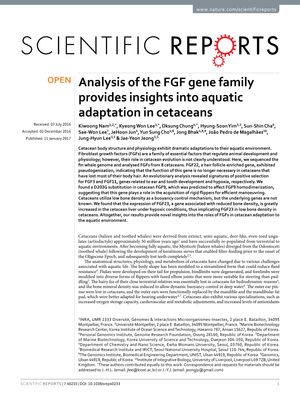Analysis of the FGF Gene Family Provides Insights into Aquatic Adaptation in Cetaceans
January 2017
in “
Scientific reports
”

TLDR Whale genes show changes that help them live in water, like less hair and better flippers.
In 2017, researchers sequenced the fin whale genome and analyzed fibroblast growth factors (FGFs) from 8 cetaceans to understand their role in cetacean evolution and adaptation to aquatic life. They discovered that FGF22, associated with hair follicles, had become a pseudogene, reflecting the loss of body hair in cetaceans. Positive selection was identified in FGF3 and FGF11, which are linked to ear and tooth development and adaptation to hypoxia, respectively. A specific mutation (D203G) in FGF9 was found to potentially impact homodimerization, suggesting a role in the development of rigid flippers for swimming. Additionally, FGF23, a gene associated with reduced bone density, showed increased expression in cetacean liver under hypoxic conditions, indicating its involvement in cetacean buoyancy through low bone density. These findings shed light on the genetic changes underlying cetaceans' unique adaptations to their marine environment.



